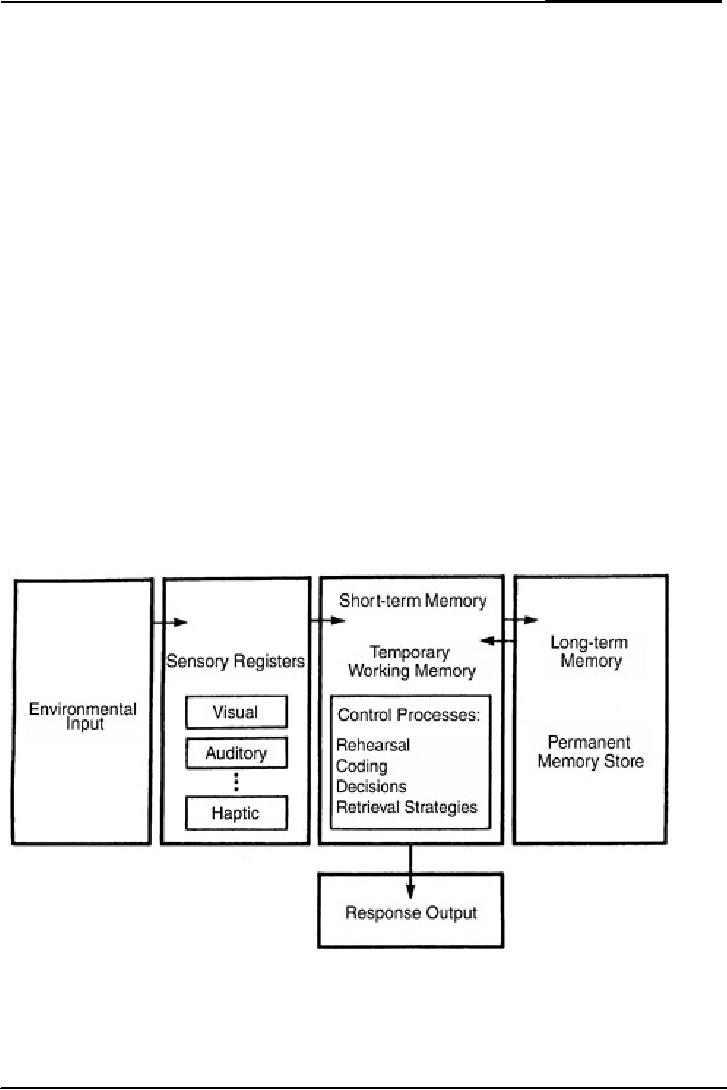 |
MEMORY:Short Term Working Memory, Atkinson & Shiffrin Model |
| << PATTERN RECOGNITION (CONTINUED):Effects of Sentence Context |
| MEMORY:Rate of forgetting, Size of memory set >> |

Cognitive
Psychology PSY 504
VU
Lesson
23
MEMORY
Short
Term Working
Memory
Memory
that we use to function is
called short term memory.
Not the same thing as
remembering
what
happened yesterday as opposed to a
long time ago. Long
Term Memory is an
infinite
storehouse.
Short Term Memory is limited
in capacity. Using the
computer analogy, STM can
be
compared
to RAM.
Attention
is an integral part of short
term memory. Attention is
very important in short
term
working
memory. Because we can not
do any thing without paying
attention. For instance if
we
are
adding two numbers without
attention we can not add
them. Working memory is one
of the
most
important topics of cognitive
psychology along with
attention. The memories that
are
currently
active are often referred to
as working memory because
they are the knowledge
which
we
can currently work with.
Working memory pull out
the information from our
long term memory.
Working
memory also understand our
information and input. But
working memory does not
do
more
works at the same time
because Short Term Memory is
limited in capacity.
Cognitive
psychologists use the term
short term memory for
this kind of memory but
some time
use
a term short term working
memory. Working memory
operates in the present
moment. This is
also
called here and
now.
Atkinson
& Shiffrin Model
Atkinson
and Shiffrin presented a
memory model.
First
of all the input comes in
sensory register from
environment. This information
may be visual
or
auditory etc. then this
input goes to short term
memory. Arrows are showing
this process.
Sometimes
we listen a word that we
have listened ago. It has
been stored in our long
term
memory.
Short term memory pull
out information from long
term memory and match
this
information
with environmental input or
information and then
response out put.
70

Cognitive
Psychology PSY 504
VU
In
short term memory there
are control processes. These
processes happened in short
term
memory.
These are rehearsal, coding,
decisions and retrieval
strategies.
Like
when someone tells us
telephone number we want to
store it in our mobile.
Until we do not
store
this number we rehearse the
number in our mind. If we
want to remember the
information,
for
long term, we code the
information in someway. We make
decisions about information at
our
short
term memory stage. Or short
term memory makes decisions.
The strategies of revision
are
also
present in our short term
memory. For example if we
are shopping the things in
market we
make
decisions to buy the
things.
So
the short term memory is
very significant in our
memory. We do all things in
our short term
memory.
Our current information goes
into long term memory
and stored information in
long term
memory
comes in short term memory.
For example a depressive
patient remind all his or
her past
life
events that make him or
her more depressive. So
therapists help patient to
forget old things.
These
old things are stored in
long term memory.
71
Table of Contents:
- INTRODUCTION:Historical Background
- THE INFORMATION PROCESSING APPROACH
- COGNITIVE NEUROPSYCHOLOGY:Brains of Dead People, The Neuron
- COGNITIVE NEUROPSYCHOLOGY (CONTINUED):The Eye, The visual pathway
- COGNITIVE PSYCHOLOGY (CONTINUED):Hubel & Wiesel, Sensory Memory
- VISUAL SENSORY MEMORY EXPERIMENTS (CONTINUED):Psychological Time
- ATTENTION:Single-mindedness, In Shadowing Paradigm, Attention and meaning
- ATTENTION (continued):Implications, Treisman’s Model, Norman’s Model
- ATTENTION (continued):Capacity Models, Arousal, Multimode Theory
- ATTENTION:Subsidiary Task, Capacity Theory, Reaction Time & Accuracy, Implications
- RECAP OF LAST LESSONS:AUTOMATICITY, Automatic Processing
- AUTOMATICITY (continued):Experiment, Implications, Task interference
- AUTOMATICITY (continued):Predicting flight performance, Thought suppression
- PATTERN RECOGNITION:Template Matching Models, Human flexibility
- PATTERN RECOGNITION:Implications, Phonemes, Voicing, Place of articulation
- PATTERN RECOGNITION (continued):Adaptation paradigm
- PATTERN RECOGNITION (continued):Gestalt Theory of Perception
- PATTERN RECOGNITION (continued):Queen Elizabeth’s vase, Palmer (1977)
- OBJECT PERCEPTION (continued):Segmentation, Recognition of object
- ATTENTION & PATTERN RECOGNITION:Word Superiority Effect
- PATTERN RECOGNITION (CONTINUED):Neural Networks, Patterns of connections
- PATTERN RECOGNITION (CONTINUED):Effects of Sentence Context
- MEMORY:Short Term Working Memory, Atkinson & Shiffrin Model
- MEMORY:Rate of forgetting, Size of memory set
- Memory:Activation in a network, Magic number 7, Chunking
- Memory:Chunking, Individual differences in chunking
- MEMORY:THE NATURE OF FORGETTING, Release from PI, Central Executive
- Memory:Atkinson & Shiffrin Model, Long Term Memory, Different kinds of LTM
- Memory:Spread of Activation, Associative Priming, Implications, More Priming
- Memory:Interference, The Critical Assumption, Limited capacity
- Memory:Interference, Historical Memories, Recall versus Recognition
- Memory:Are forgotten memories lost forever?
- Memory:Recognition of lost memories, Representation of knowledge
- Memory:Benefits of Categorization, Levels of Categories
- Memory:Prototype, Rosch and Colleagues, Experiments of Stephen Read
- Memory:Schema Theory, A European Solution, Generalization hierarchies
- Memory:Superset Schemas, Part hierarchy, Slots Have More Schemas
- MEMORY:Representation of knowledge (continued), Memory for stories
- Memory:Representation of knowledge, PQ4R Method, Elaboration
- Memory:Study Methods, Analyze Story Structure, Use Multiple Modalities
- Memory:Mental Imagery, More evidence, Kosslyn yet again, Image Comparison
- Mental Imagery:Eidetic Imagery, Eidetic Psychotherapy, Hot and cold imagery
- Language and thought:Productivity & Regularity, Linguistic Intuition
- Cognitive development:Assimilation, Accommodation, Stage Theory
- Cognitive Development:Gender Identity, Learning Mathematics, Sensory Memory